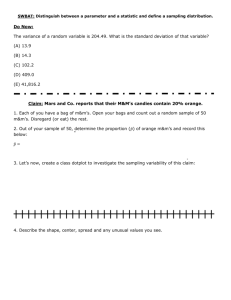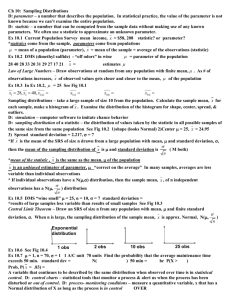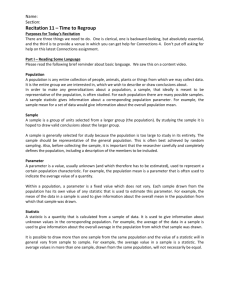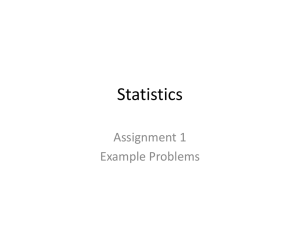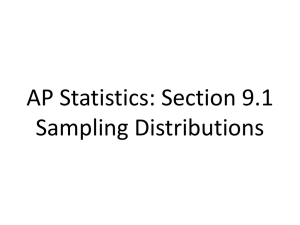Chapter 5 Review
advertisement
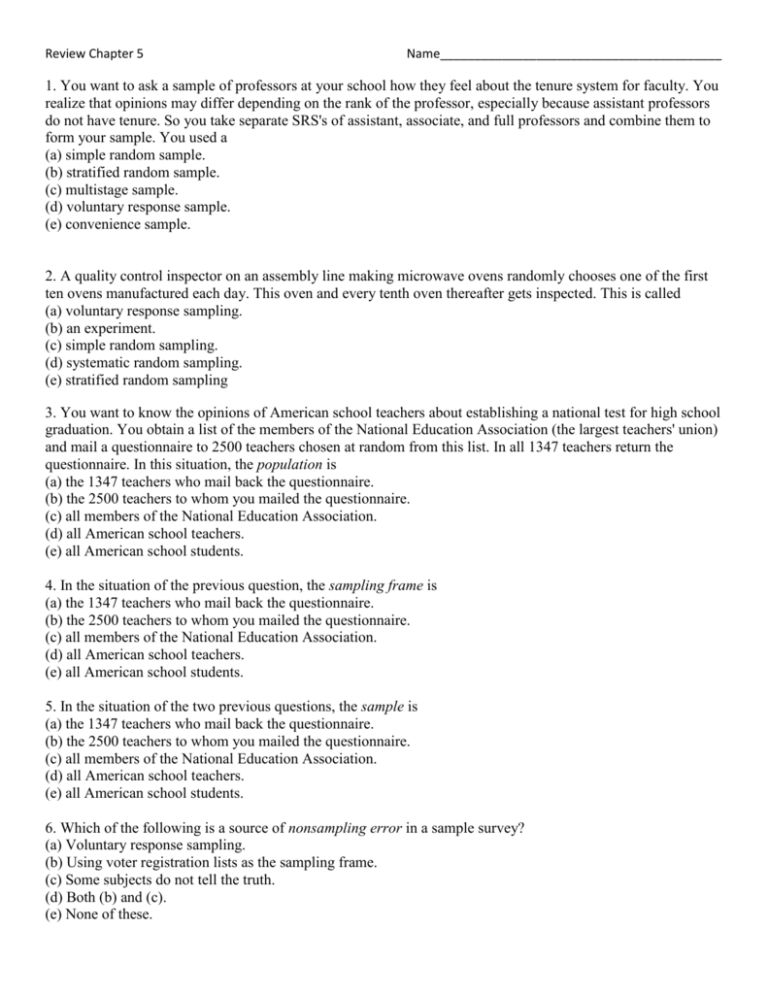
Review Chapter 5 Name_________________________________________ 1. You want to ask a sample of professors at your school how they feel about the tenure system for faculty. You realize that opinions may differ depending on the rank of the professor, especially because assistant professors do not have tenure. So you take separate SRS's of assistant, associate, and full professors and combine them to form your sample. You used a (a) simple random sample. (b) stratified random sample. (c) multistage sample. (d) voluntary response sample. (e) convenience sample. 2. A quality control inspector on an assembly line making microwave ovens randomly chooses one of the first ten ovens manufactured each day. This oven and every tenth oven thereafter gets inspected. This is called (a) voluntary response sampling. (b) an experiment. (c) simple random sampling. (d) systematic random sampling. (e) stratified random sampling 3. You want to know the opinions of American school teachers about establishing a national test for high school graduation. You obtain a list of the members of the National Education Association (the largest teachers' union) and mail a questionnaire to 2500 teachers chosen at random from this list. In all 1347 teachers return the questionnaire. In this situation, the population is (a) the 1347 teachers who mail back the questionnaire. (b) the 2500 teachers to whom you mailed the questionnaire. (c) all members of the National Education Association. (d) all American school teachers. (e) all American school students. 4. In the situation of the previous question, the sampling frame is (a) the 1347 teachers who mail back the questionnaire. (b) the 2500 teachers to whom you mailed the questionnaire. (c) all members of the National Education Association. (d) all American school teachers. (e) all American school students. 5. In the situation of the two previous questions, the sample is (a) the 1347 teachers who mail back the questionnaire. (b) the 2500 teachers to whom you mailed the questionnaire. (c) all members of the National Education Association. (d) all American school teachers. (e) all American school students. 6. Which of the following is a source of nonsampling error in a sample survey? (a) Voluntary response sampling. (b) Using voter registration lists as the sampling frame. (c) Some subjects do not tell the truth. (d) Both (b) and (c). (e) None of these. 7. If we choose a simple random sample (SRS) from a population, we can be sure that the ________which we compute from our SRS is a/an ________ estimate of the population's true________. We also know that we can reduce the ________ of our result as desired by taking a large enough sample. The appropriate sequence of words to complete this statement is (a) parameter, variation, statistic, unbiasedness (b) parameter, unbiased, statistic, variation (c) statistic, variation, parameter, unbiasedness (d) statistic, variaton, parameter, bias (e) statistic, unbiased, parameter, variation 8. A sample of student opinion at a Big Ten university selects an SRS of 200 of the 30,000 undergraduate students and a separate SRS of 100 of the 5,000 graduate students. This kind of sample is called a (a) simple random sample. (b) stratified random sample. (c) systematic random sample. (d) multistage sample. (e) biased sample. 9. An opinion poll asks a sample of 1100 people whether they support reducing the number of legal immigrants to the U.S.; 53% of these 1100 people say "Yes." The number 53% is a (a) margin of error. (b) statistic. (c) bias. (d) parameter. (e) reliability. 10. The local school board posts average SAT Math scores for each high school in the district. For one particular high school, the average math score is given as 516. A statistics teacher at that high school thinks that this is too high. He takes a random sample of 100 students and finds that their average SAT Math score is 486. Population: _______________________________________________ Sample: _______________________________________________ Parameter: _______________ Statistic: _______________ 11. When constructing a 95% confidence interval for proportions, what would be the approximate margin of error for a sample size of 200 people? ___________ Vocabulary Match Bias Convenience Sample Margin of Error Nonresponse Error Nonsampling Error Parameter Population Probability Sample Processing Error Question-Wording Bias Random Sampling Error Response Error Sample Sampling Frame Simple Random Sample Statistic Stratified Sample Systematic Sample Undercoverage Variability Voluntary Response Sample Error which occurs when an individual chosen for the sample cannot be contacted or refuses to cooperate Systematic favoring of certain outcomes A sample of size n individuals from the population chosen in such a way that every set of n individuals has an equal chance to be the sample actually selected Deviation between the sample statistic and populations parameter caused by chance in selecting a random sample A number that describes the population Error that occurs when a subject gives an incorrect response Bias created by the wording of the survey question(s) Error in mechanical tasks such as in doing arithmetic or in entering responses into computer The part of the population we actually collect information Any sample which uses chance to select the sample Sampling error not related to the act of selecting a sample from the population Sample consisting of people who choose themselves by responding to a general appeal The entire group of individuals about which we want information A sample obtained by dividing the population into subgroups according to various homogeneous characteristics and then selecting members from each subgroup for the sample Number that describes a sample List of individuals from which a sample is actually selected How spread out the values of the sample statistic are when we take many samples Sample which chooses the individual easiest to reach Measure of the sampling variability which tells how much confidence we have in the results of a survey Bias which occurs when some groups in the population are left out of the process of choosing the sample A sample obtained by numbering each element in the population and then selecting every third or fifth or tenth, etc., number from the population to be included in the sample




